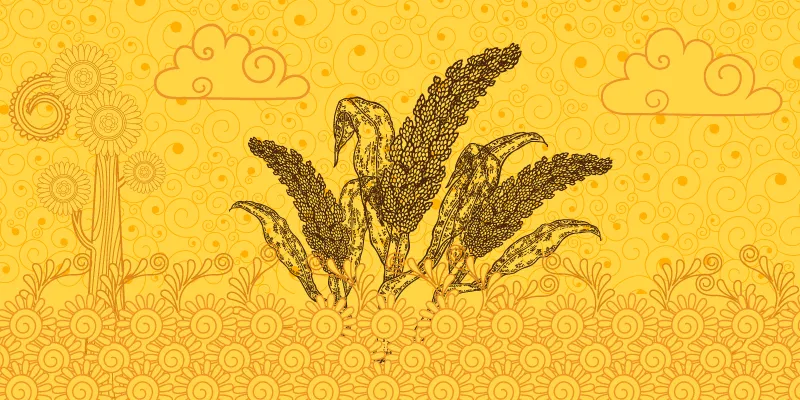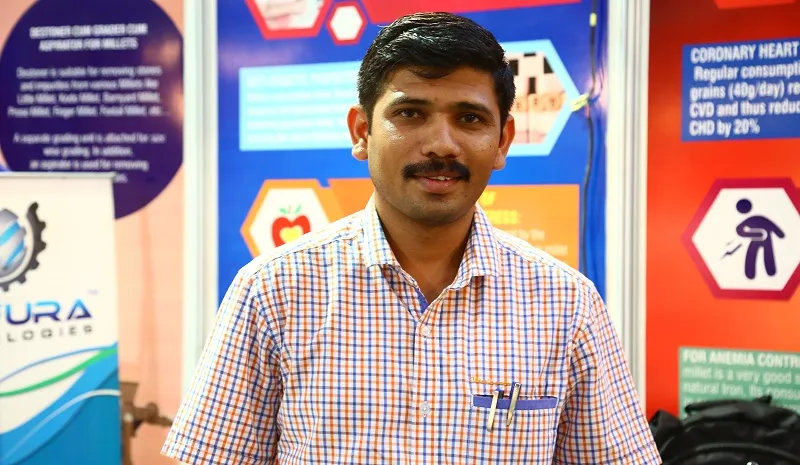Can research revolutionise millets?
Despite being the largest producer of millet in the world, India has not been able to harness the potential of millets. A Hyderabad-based research institute wants to change it.
Millets, a family of highly variable small-seeded grasses, are cultivated around the world as fodder or food for humans, with India being the largest producer.
Millets need less water, less fertilisers and are less prone to attack by pests. Overall, they are low-maintenance and low-input crops. So why aren’t farmers producing more millets?
Millets are anti-obesity, good for heart and rich in iron. So, why is the market not flooded with millets products?

To answer these questions and to make the leap in the direction of building a millet-friendly ecosystem (for farmers and consumers), the Directorate of Sorghum Research (DSR) was upgraded to the Indian Institute of Millets Research (IIMR) in 2014. The centre is a part of Indian Council of Agricultural Research (ICAR), which works on crop improvement, processing and value addition for millets like finger millet (ragi), pearl millet (bajra), foxtail millet, barnyard millet, proso, and kodo. The institute researches (and develops) consumable products as well.
Over the last three years, the institute’s research has resulted in the development of healthy and innovative food products from millets. This includes cold extruded (like vermicelli, pasta) and hot extruded (Kurkure-like snack) food products. There’s even millets puffs made from the puff gun machine. Some of these products are in the market already while others are still in labs.
Sangappa is a scientist working with the Agri Business Incubation Programme at IIMR. He, along with a few other fellow scientists, helped YourStory understand the ongoing research in millets at IIMR and other agricultural universities across the country.
Related read - Meet the young economist-turned-entrepreneur Vikram, who is stirring up a millet revolution
Stage 1: Crop production
Over the years of conducting research, IIMR has developed more than 30 cultivars of sorghum while many new cultivars of other millets including foxtail millet, finger millet, proso, kodo will be released soon.
Amasiddha from IIMR and Yogeesh N from University for Agricultural Sciences, Raichur, are agricultural scientists working with IIMR on increasing the yield of millets. Their research is aimed at improving the quality of crop in terms of yield. It’s a three-step process, which includes:
- Selection: Selecting the suitable varieties of millets seeds for specific geographies and conditions.
- Mutation: Millets are mutated in order to achieve the diversity of crops (more diversity means more options).
- Hybridisation: It is is not yet standardised in India. Using processes like hot water treatment methods, varieties with better yield can be produced. These will be standardised as well.
The above three steps are intended to come up with high yield(6-10 quintals/acre) and short durations crop variety, which can withstand harshness of weather, diseases and pests.

Explaining the situation, Yogeesh said,
The current millets varieties are low yield (2-4 quintals/acre) and long-duration crops, which makes it less lucrative for farmers to cultivate millets.
Recently, IIMR received a request from the Uttar Pradesh government to share the best practices to cultivate jowar in the state. Sangappa said, “We will provide them with the information on the cultivars that are suitable to grow in the state. If they want us to produce the seeds, we can do that as well.”
Also read : Karnataka govt makes millets count, aims to make farmers into entrepreneurs
Stage 2: Millet food products
Given the health benefits of millets, agricultural scientists engage in making healthy food products from millets, which can help in combating specific diseases as well. For this, product-specific cultivars(specific kind of grains for cookies etc) are produced first, which is then processed at the farm level with the help of farmers and self-help groups.
Cookies made from jowar (sorghum), ragi and multi-millet composition are being experimented currently. The development of new food products is aimed at addressing malnutrition, anemia and other diseases. Some of the health benefits of millets include:
- Coronary Heart Disease (CHD): Regular consumption of whole millet grains(40g/day)reduces the risk of cardiovascular disease, and this reduces the risk of CHD by 20 percent.
- For anemia control: Finger millet is a very good source of natural iron. Its consumption helps in conditions of anemia and in keeping malnutrition, degenerative diseases, liver disorders and asthma at bay.
- Anti-diabetic properties: Millets consumption lower blood glucose response and glycosylated haemoglobin, thus helping in reducing the risk of diabetes mellitus.
- Anti-cancer properties: Millet extracts have anti-prolific effects on cancer cell line, inhabit DNA damage and induce the production of phase-2 detoxifying enzymes.
Apart from the above, millets are anti-obesity, anti-hypersensitive, and beneficial in treating stomach ulcers and gall stones. Millets consumption also prevents allergic reactions and reduces oxidative stress.
With its millet-based cookies, vermicelli, pasta, pizza (using the millet flour) and Kurkure-like snack (with no additives), IIMR is set to take on the market in future.
In addition, the research institute has developed machines for harvesting and processing millets in collaboration with farmers and entrepreneurs.

Composition and collaboration
More than 35 scientists are working with IIMR, divided into departments like plant protection, plant improvement, processing, value addition and social sciences. The funds for the research are granted by ICAR majorly. The institute also works with private players like Britannia and ITC who partner for value chain development and sometimes fund the institute's research on specific products like cookies, pastas and vermicelli.
Sangappa pointed out the need to create awareness about millets(among farmers and consumers).He says, “We are sensitising the State and Central government about the importance of millets and, very soon, we expect millets policy to come in place.” He has two important suggestions that can further boost the millet production and consumption in the country:
- Millets can be introduced in mid-day meals.
- More millets need to be included covered under minimum support price. Right now, only jowar, bajra and ragi make up the list.
IIMR has an all-India Coordinated Research Project Committee with the agricultural networks across the country, including State agricultural universities. They share the research work and progress among each other. For example, Tamil Nadu and Karnataka have made significant progress in producing better quality ragi over the years, which can be shared with other States.
According to Avinash, scientist at IIMR, adoption of millets production is driven highly by market and it’s important to have support of some favourable policies for these crops.
The market is you and me equally. So, I ask, will you buy millets products if you come across them the next time you go for grocery shopping?







